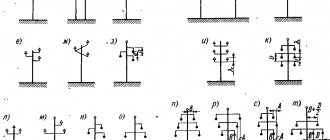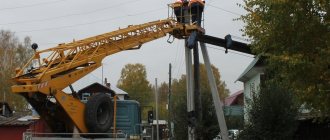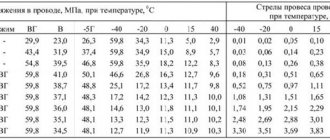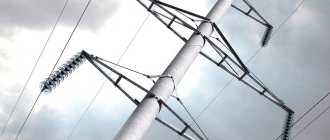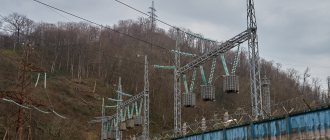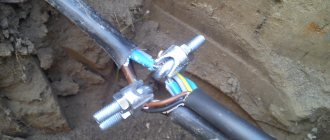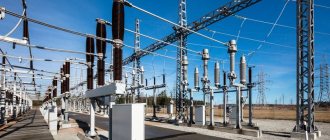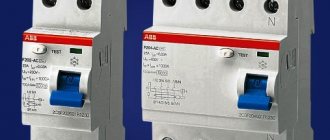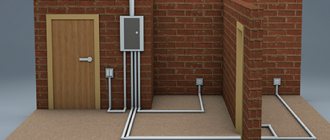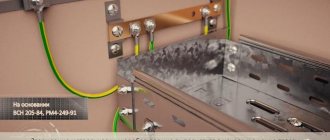What is the distance between high-voltage power transmission line supports: norms
Electrical energy, which is important for everyone, is transmitted through cables suspended on poles of different designs and electrical transmission lines. For safety, the distance between power line supports in open areas or in the city is extremely important.
Nuances on which the distance between the pillars depends. In different areas, the distance between power line poles and the height of the wire will differ. The values must be calculated based on the fact that the wire tension,
as well as sagging create large horizontal loads between the supports.
Distance between transmission line towers: 10 kV, 110 kV and 35 kV transmission line poles
The electricity everyone needs is transmitted through wires suspended from poles of various designs and power lines. For safety, the distance between power line supports and their height are of great importance. GOST regulates all sizes based on the current strength in the wires, material and design of the support. The location of power transmission line supports in open areas or in populated areas is also of great importance.
Factors on which the distance between pillars depends
In different places, the distance between power line poles and the height of the wire differ. The values are calculated based on the fact that the tension of the wire and its sagging will create prevailing horizontal loads between the supports.
The second important element is the strength of the icing in a particular area and the resistance to wind swing. The value is calculated for each region separately depending on climatic conditions. In addition, what distance should be between the pillars and supports depends on the following factors:
- network voltage,
- the type of settlement through which the line passes,
- distance from populated areas,
- number of overhead lines,
- wire type.
Adjustment of distances between power transmission line poles is carried out primarily in populated areas. Based on general requirements, supports should not block free access to the yard, block the path for pedestrians, or stand directly in front of the front facades of buildings and entrances to houses.
A fence is installed on the side of the road to prevent cars from hitting the supports. These are concrete pillars, bollards and high barrier curbs.
Each high-voltage pole must be marked. At a height of 2.5–3 m, the following data is applied:
- Serial number.
- Network voltage value.
- Year of installation of the structure.
- Width of the security zone.
- Distance from ground to communication cables.
- Phone number of the owner - the organization operating this network.
Metal structures are protected from corrosion and are regularly coated with a protective primer or ship paint.
The numbering of supports is carried out from the current source.
The maximum deflection of wires is calculated taking into account icing, which is divided into 6 categories, and wind force. Tensioners are installed at the suspension points, ensuring a minimum angle of deviation of the horizontal position of the cable and the least sagging.
Bare wire is used for lines outside cities and towns. It will be installed at the maximum possible height directly on the insulators using special bolted tires.
Mains voltage
The distance between the supports is determined depending on the voltage in the wires they carry:
- 0.4–1 kV – distance within 30–75 m,
- 10 kV – spans up to 200 m,
- 220 kV – distance between supports up to 400 m,
- over 330 kV - supports can be located from each other at a maximum distance of 700 m.
The wires are suspended in parallel on insulators at a height that also depends on the voltage. If it is up to 1000 V, then the line is fixed at a height of 7 m.
The permissible sag and the distance to the bottom point are also determined depending on the voltage. In cities, towns of individual housing construction and SNT, the lowest sagging point should be higher than 6 m from the ground.
Span between supports in residential communities and beyond
A settlement of any type, a holiday village, a city and a village have the same status for the passage of power lines through them. The distance between the pillars is determined to be up to 70 m, provided that at the moment of maximum icing they do not sag below 6 m in places where the road and sidewalk pass. The wire must be insulated.
Street lighting in the private sector is installed on poles located along the road at a distance of 30–50 m from each other. Electricity is supplied to the garage and house through a self-supporting insulated wire. The entry point must be at least 4 m from the ground surface.
If a cable is pulled from a pole through a site, an intermediate support is installed, providing a suspension at a height of 7 m and a maximum sag of up to 6 m. Trees are planted at a distance of more than 5 m from the wire. Directly below the line you can make a vegetable garden with plants 0.5 m tall. The shrub is planted at a distance of at least a meter from the cable projection line.
High-voltage power lines over 300 kV should not pass through populated areas of any type. The distance from the nearest residential building must be 100 m. The distance to the border of the site without buildings is the minimum width of the sanitary zone in one direction.
The basis for calculating the length of transmission line spans is TP 25.0038, which reflects the development of design distances for 0.28–35 kV overhead line supports. A typical project contains tables of span sizes between reinforced concrete and metal supports depending on the degree of icing, wind load and type of wire cross-section and insulation.
Based on the data contained in it, you can design at what distance to install a pole with SIP. If an electric wire, metal or copper, is stretched without insulation, then this will determine how much the span between the pillars will change.
Type of power line and voltage, how to determine visually
What voltage is in the power line, and accordingly, what are the parameters of the zone, will be found out at the local power supply. You can roughly determine the characteristics by analyzing the appearance of the high-voltage line. Security zone of 10 kV and 0.4 kV power lines are the most common in populated areas.
These overhead lines are usually located in cities, equipped with SIP or aluminum wire on relatively low supports with oversized insulators - white, brown, glass (transparent). Overhead lines with 10 kV and more are equipped with large insulators, often they are brown ceramic, the height of the support is about 9 m. Lines with 0.4 kW also have a security gap, but much smaller, up to 2 m.
“Aerial towers” of 35–750 kV and more are the highest and largest supports, usually located on the outskirts of populated areas. In the forests, special clearings are cut down for them, with a width equal to the protective zones, however, as well as for other types of power lines. Towers for 35, 110, 220 kV are equipped with one core per phase, and then, according to power options, respectively, 300 - 2, 500 - 3, 750 - 4 or 5. Insulating garlands differ in the number of “plates”: 35 kV - 3 or 5 pcs., 110 - 6 or 8, 220 - 10 or 15, 500 and 750 - from 20.
How much is the distance between lighting poles, lamp posts?
Distance between lamp posts, lighting supports
When installing lamp posts, lighting supports in the city, along the road, the distance between the outdoor lighting supports of the city is determined based on the number of lighting lamps installed on the support, their power and the height of the lamp installation above the road. The distance between reinforced concrete lighting poles when installing lamp poles along roads is determined using the same table. The calculation of the distance between lighting supports is based on road illumination standards. This calculation allows you to answer the questions: “How many meters are between the lamp posts?”, “What is the distance between the lamp posts?”, “What is the span between the lamp posts?”. The ratio of the pitch of lamps to the height of their suspension on streets and roads of all categories should be no more than 5:1 with one-sided, axial and rectangular placement of lamps and no more than 7:1 with a checkerboard placement pattern. The table shows the maximum distances between lighting supports, taking into account the required illumination of the roadway.
How many meters between the support and the road when installing lighting poles?
Electrical installation of outdoor lighting fixtures is carried out on street lighting poles, lighting masts, power line poles and other structures. To illuminate this or that part of the street, it is necessary to install an external lighting system in accordance with the standards for installing electrical poles.
Connecting electricity from the pole to the house
Specialized companies are engaged in connecting the cable from the power pole to the distribution box of the house. Before contacting specialists, owners of private houses need to obtain permission from an organization that deals with the supply and connection of electricity. It is necessary to study all the requirements for connecting a private building to the electrical network.
To connect a home, it is necessary to prepare a complete description of the home electrical network with calculations of the power and mode of each pantograph. Based on this project, a permit will be issued.
Electrical installation work must be carried out by employees of the organization who have the appropriate license. Before starting work, you need to decide on the connection method. Today, there are overhead and underground methods for connecting electrical current.
Air way
This method of connecting the cable to the house is interesting because it takes a minimal amount of time and does not require large financial costs. To connect by air, for example, a wooden frame house, self-supporting insulated wires are used that will last at least thirty years. But according to eyeliner standards, not all private houses are suitable. The cable entry into the house must be located at least 2.75 m from the ground.
If the residential structure is below this mark, special racks should be installed. Such devices can have a straight or curved shape. The racks differ not only in shape, but also in the method of mounting on the wall:
Electrical energy is removed from sources using cables made from different materials. Copper wires are required in smaller sizes, but are significantly more expensive. Therefore, wiring from racks to a low-rise building or country house is mainly carried out using cable products with aluminum cores.
The distance from the foundation of a private house to a high-voltage pole should be no more than 10 meters. This applies not only to houses, but also to country houses and other residential buildings. If the actual length from the power line pole exceeds this value, then it is necessary to install an auxiliary support on a separate foundation.
The distance from the electric pole to the additional support post should not exceed 15 meters. The minimum distance from the outermost post to a residential building must be at least 1.5 meters to window openings and loggias; 1 meter is the minimum distance to the façade walls of buildings or foundations.
Experts carry out wiring of an electrical wire through the wall of a house built of wood using a steel pipe. If the structure is built of brick on a concrete foundation, then an ordinary plastic pipe is quite suitable for this purpose.
Closed method
Discharging the cable using the closed method through a trench dug underground requires more time and material resources. You will need about 15 meters more wires.
In this case, an additional agreement may be required to carry out earthworks in a certain location, which is also fraught with unnecessary financial costs.
Before you begin laying the cable, you should dig a trench and install protective insulation in the form of a polyethylene pipe. Laying in soil with increased chemical activity will require increased insulation protection. You can resort to using aluminum or lead sheathing.
Then you need to outline the path along which the trench will go. To use less insulating material and spend less physical effort digging a ditch, it is best to draw a trench directly from the power line to the site. But, unfortunately, this is not always possible. Departures from the direct road may be required under the following circumstances:
Once the route for laying the cable is determined, you need to dig a deep trench - about 70–80 cm. To ensure power supply to buildings under the soil, you need to use an armored cable with copper conductors. The cable insulation must be much stronger.
All underground work on installing wires from a power line pole to a residential building cannot be carried out with one’s own hands. This should be done by employees of special companies that have permission to provide this type of service. The underground method of supplying cables from a high-voltage source will increase the protective functions against harmful radiation from power lines.
The distance at which power lines are installed to the fence
In the matter of building a house and equipping its territory, many issues are important. This includes the distance from the power line to the fence, which everyone who has started building a fence for their private plot should know about. The safety of those who come to the territory on vacation or permanently reside on the territory depends on the correct calculation of the distance from power lines to the fence of a private house.
Diagram with dimensions of the location of the fence from the power line
Important points
A person uses electricity all the time, be it at home, in the country or in the office. But few people delve into the fact that power lines not only supply a useful resource, but can also be harmful due to magnetic fields, and in case of failures they become unsafe for humans. It is imperative to adhere to the established rules, which indicate the required distance from the support to the fence of a residential private house for the following reasons:
- To preserve the health of building occupants.
- In order not to suffer from the effects of airborne electromagnetic fields that have a detrimental effect on the human brain.
- In the security zone of power lines, where the voltage level is especially dangerous for humans, the issue of locating residential buildings is especially acute. If the level of danger is off the charts, the area is fenced off with an industrial fence and a ban on construction in this area is put in place.
Power line protection zone diagram
Therefore, SNiP establishes distances from power lines to the fence of a house not just so that people do not receive fines for violations, but for the safety of the population of cities and villages.
The sanitary standards related to power lines clearly and in detail describe at what distance from power lines fences can be installed. This distance depends on the voltage level in the wires. In places of special tension, which are specially equipped, there are sanitary zones, near which it is prohibited to place fences and build residential buildings.
Safe distance from power lines
A requirement is established for the distance from the fence at the dacha to the place where the power line support is located, based on the voltage class.
Some owners of private plots turn to city or rural self-government bodies in order to obtain information about the voltage class in power lines located near their summer cottage.
Of course, not knowing how to determine the voltage level in the wires, it is better to do just that, so as not to unwittingly become a violator of SNiP requirements and endanger the residents of a private plot.
However, there is a method by which you can independently determine the voltage level in power poles.
Diagram of voltages in power lines of various types
If the voltage is very small, then it can be determined by counting the insulators.
How to increase your security level
Even having fully complied with all the norms and requirements regarding the distance of the fence from the poles through which electricity passes, houses built near power lines are still at risk in unforeseen situations and must protect their private sectors. This can be done in the following ways:
- Select a roof with grounding for the construction of the house,
- Install reinforcing mesh inside the wall structure. This solution will help reduce the risk of penetration of harmful electromagnetic waves into the living space,
- To increase the level of safety for home residents, fruit trees should be planted at a horizontal distance of at least 2 meters from power lines.
Minimum permissible distances from trees to power lines
Recommendations
The requirements in SNiP are prescribed primarily for the safety of people, and not to fulfill the wishes of self-government bodies. Therefore, you should not neglect safety rules, especially when it comes to electrical voltage. It is worth paying maximum attention to calculations at what distance it is safe to install a fence from power lines. Only a properly installed fence will provide comfort and limit the residents of a private plot from troubles and danger.
What additional methods of protection are there?
To increase protection from the harmful effects of fields generated by power lines, additional protection options are provided. These include:
- Shielding devices for voltages from 10 kV.
- Roofs made from metal tiles or corrugated sheets should be grounded. The roof is grounded only if the distance from it to the power lines is small.
- The presence of reinforcing mesh - the kind that is laid in reinforced concrete walls.
At present, the harmful effects of power lines on human health have not been officially confirmed. Such studies have not been conducted in Russia. But this does not mean that the problem does not exist.
Possible damage zone in an accident
According to the observations of foreign scientists, a huge number of people who live or work in close proximity to high-voltage structures experience their negative influence, they often feel unwell. In addition, the risk of nervous ailments and the development of cancer increases.
Design parameters of overhead power lines
The main design parameters of an overhead line (OL) are the span length, the sag of the wires, the distance from the wires to the ground, to the coverage of roads and other engineering structures crossed by the line (dimensions).
The length of the intermediate span is the distance along the line between two adjacent intermediate supports. The span length of a 0.4 kV overhead line ranges from 30 to 50 m and depends on the types of supports, brand, wire cross-section, as well as the climatic conditions of the area.
The sag of the wires is the vertical distance between an imaginary straight line connecting the attachment points of the wires on two adjacent supports and the lowest point of their sag in the span. The sag depends on the same factors as the span length.
The dimension of an overhead line is the smallest vertical distance from the wires to the surface of the earth, rivers, lakes, communication lines, highways and railways, etc. The size of the overhead line is regulated by the PUE and depends on the voltage and people visiting the area.
To ensure normal operation and safe maintenance of overhead lines, the distances from them to various structures must comply with the standards established by the PUE. Thus, the vertical distance from the wires to the ground surface with the greatest sag should be at least 6 m in populated areas; the distance from the wires to the ground can be reduced in hard-to-reach areas to 3.5 m and in inaccessible areas to 1 m. Distance 4 by the horizontal distance from overhead line wires to balconies, terraces, and windows of buildings must be at least 1.5 m, and to blank walls at least 1 m. The passage of overhead lines over buildings is not allowed.
The overhead line route can pass through forests and green spaces. The horizontal distance from the wires to the crown of trees and bushes at the greatest sag should be at least 1 m.
Overhead line supports must be located at least 1 m from pipelines, at least 2 m from underground sewer wells and water intakes, at least 1 m from gas stations, and 0.5-1 m from power cables.
Crossing overhead lines of navigable rivers is not recommended by the rules. When crossing non-navigable and freezing small rivers and canals, the distance 4 from the overhead line wires to the highest water level must be at least 2 m, and from the ice surface at least 6 m. The horizontal distance from the overhead line support to the water must be no less than the height of the power line support.
The angle of intersection of overhead lines with streets, squares, and various structures is not standardized. It is recommended to carry out intersections of overhead lines up to 1 kV with each other on cross supports, and not in spans.
Intersections of overhead lines with overhead communication and signaling lines should be carried out only in the span of the line, and the overhead line wires should be located higher.
The distance between the upper wire of the communication line and the lower overhead line must be at least 1.25 m. Special requirements are placed on overhead line wires in the crossing span: they must be multi-wire, with a cross-section of at least 25 mm2 (steel and steel-aluminum) or 35 mm2 (aluminum) and secured to supports with double fastening. Overhead line supports that limit the span of the intersection with communication lines of classes I and II must be anchored; when crossing with communication lines of other classes, intermediate supports are allowed (wooden ones must have reinforced concrete attachments).
When crossing underground cable communication and alarm lines, overhead line supports should be located at the greatest possible distance from the cable (but not less than 1 m between the grounding of the support and the cable in cramped conditions).
The proximity of overhead lines to overhead communication lines is allowed at a distance of at least 2 m, and in cramped conditions - at least 1.5 m. In all other cases, this distance is taken to be no less than the height of the largest support of the overhead line or communication line.
When crossing non-electrified main public railways, the transition supports of overhead lines must be anchored; access railway tracks are allowed to cross overhead lines on intermediate ones (except wooden ones) at an angle of at least 40 degrees. and as close as possible to 90 degrees. Electrified railways must be crossed by a cable insert into the overhead line.
The intersection of overhead lines of motor roads of category I must be carried out on anchor supports; other roads are allowed to be crossed on intermediate supports. The cross-section of overhead line wires passing over roads must be at least 25 (steel-aluminum and steel) and 35 mm2 (aluminum). The shortest distance from the overhead line wires to the road surface must be at least 7 m. When crossing tram and trolleybus lines, the shortest distance from the overhead line wires to the ground surface must be at least 8 m.
The figure shows a diagram of the overhead line anchor span and the crossing span with the railway.
The vertical distance from the line wires to the ground surface in an uninhabited area during normal operation must be at least 6 m for overhead lines up to 110 kV, 6.5, 7, 7.5, 8 m, respectively, for overhead lines 150, 220, 330, 500 kV.
Distance from power lines to the fence of a residential private house
Every day a person uses electricity, which comes to our home through power lines. The distance from the fence of a private house to the power line plays an important role. Because magnetic waves emitted by power lines negatively affect human health. But few people delve into the essence of this problem. Therefore, he ignores the installation of more and more new poles near the residential area.
High voltage power lines
However, it is still recommended to adhere to the rules established by law. The health of all family members may depend on this. The reasons why you should adhere to the established rules are obvious:
- In the power transmission line security zone in the immediate vicinity of the power line itself, the area can be fenced off with an industrial fence. In this case, a complete ban is placed on the construction of residential buildings near the dangerous area.
- To protect human health, since electromagnetic fields negatively affect the state of the human brain.
Return to contents
Current standards
Based on current sanitary standards, SanPiN 2971-84, a distance of 20 m from the fence installation site to the 110 kV overhead line support is considered safe.
Schematic drawing of the security zone
If the voltage on the power line reaches 500 kV, then the norm for the construction of any capital building is considered to be a distance of 30 m. If the voltage threshold on the power line reaches the range of 750 kV, then the minimum distance for the construction of fences and other structures is considered to be 40 m. If the threshold The voltage of the power line reaches 1,150 kV, then the distance from the support to the objects must be at least 55 m.
Scheme of binding security zones depending on voltage
If you plan to build a residential building near a power line, then the level of its impact can be minimized in the following ways:
- Use shielding devices and structures. They will protect housing and become an obstacle to established lines.
- The support should be located as far as possible from the residential property. Therefore, the house should be built at a certain distance.
Building codes also prescribe other regulations that must be followed. This includes the distance from the fence to the greenhouse, the distance from the toilet to the fence, and many others.
Permissible distance threshold
If we take into account sanitary and building standards, then grounded roof coverings provide good protection from power lines. As an option - from metal tiles or profiled flooring. The reinforcing mesh inside the structure will reduce the impact of electromagnetic waves that are inherent in a pole with power lines.
The rules for electrical installations specify the optimal distance to objects from hanging wires.
The dacha plot must be located at a safe distance from power lines. A horizontal distance of 2 m must be maintained from trees. But it is not necessary to completely remove orchards, as is prescribed in the current regulations.
The distance of the wire (6-10 kV) towards the ground should be:
- 3 m between the wires themselves and rocks, cliffs and slopes,
- 5 m between the lines and the surface of the water (swamp, swamp, etc.),
- 6 m to the ground in a non-residential area,
- 7 m to the ground surface in a residential area.
Scheme of permissible distances
To the nearest gas station or storage areas for flammable and explosive substances, you will need a gap of at least one and a half times the height from the ground surface to the power lines.
The distance to parallel roads is the height of the support plus five meters. Measurements are taken from the bottom of the support itself and to the edge of the subgrade. In this case, the wire itself must also be of a certain cross-section: 25 mm2 for steel or 35 mm2 for aluminum. The minimum height above the road should be 7 meters (for the passage of trucks and other large vehicles).
The gap to residential buildings should be 1.5 meters to loggias and balconies, and a meter to the surfaces of other buildings, including blank walls. Wires can pass over residential buildings, but only those that are intended to supply electricity to residential buildings.
The horizontal distance from the outer wires (220 kV) to the buildings is measured and is at least:
- 2 m for 20 kV,
- 4 m for 35 – 110 kV,
- 5 m for 150 kV,
- 6 m for 220 kV.
Schematic drawing with standards for connecting residential buildings to power lines
It is not allowed to pass lines over stadiums, swimming pools, children's institutions and educational institutions.
The length to the nearest gas pipeline, which is laid in parallel, must be at least the height of the support up to 1 kV. And it depends on the area of its application. When crossing, you will need to install protective screens. The above data does not apply to the category of underground power lines.
Legal side
It is worth noting that all the approved norms and rules are not just the whims of government officials. It must be borne in mind that the presence of power lines nearby can adversely affect the health of people living nearby. This concerns mainly the influence of the electromagnetic field. Therefore, you should not build residential premises in close proximity to power lines. The minimum distance is 100 m from the overhead line wire. Each person solves this problem in his own way.
Some are designing home ownership at a safe distance. But if this is not possible, you should worry about moving power lines underground. This is an expensive project, but people’s lives and health are more valuable. First, a trench is dug to a depth of 1 meter. You can use cable channels, tunnels and blocks. One trench can contain up to 6 cables with a distance of 20 cm between them.
There can be up to 20 cables in the tunnels.
But it must be remembered that capital construction on laid cables is strictly prohibited. This is punishable by large fines. There must be mandatory free access to power lines located underground in the event of an emergency or planned maintenance.
What is prohibited in power transmission line protection zones
Within the boundaries of the protective and sanitary space, actions that threaten the normal operation, the stability of the operation of lines, during which a danger is created for people, for the operability of the facility, or the possibility of fires, are strictly prohibited.
Directly prohibited work in the security zone of power lines (we will indicate the general list according to GOST; in R. III of Resolution 160 it is more detailed):
- placement of objects with fuels and lubricants, flammable liquids, flammable liquids;
- landfills;
- events related to explosions;
- starting a fire;
- discharge, discharge of caustic, corrosive mixtures, fuels and lubricants;
- throwing, approaching objects to supports, wires;
- you cannot climb on structures;
- any actions and stay in a segment with a special regime during thunderstorms or extreme weather.
What is prohibited without the consent of the service organization (work is highlighted separately as such, which is possible, but with the consent of the responsible enterprises, according to Resolution No. 160, paragraph 10):
- construction and installation activities, watering, planting, cutting down, as well as storing feed, fuel, etc. It is forbidden to develop roads for vehicles and machinery with a height exceeding 4.5 m;
- if the installation is underground, then excavation work and leveling using earth-moving equipment are prohibited;
- For underwater lines, activities affecting the bottom soil, arrangement of berths, movement with loose anchors, trawls, etc. are prohibited. Watering places and the allocation of fishing areas are prohibited;
- for overhead power lines, work with lifting and retractable structures is permitted if the gap from the housing, transforming segments, and objects being lifted to the closest wire is not less than according to table. 2 GOST.
Irrigation works
In GOST, irrigation works are highlighted as separate points, since they pose an immediate danger due to the increased conductive properties of water in any of its forms (splashes and even sprayed small drops). Such activities are permissible in any weather, if the stream is outside the protected space, and also if it enters it, but does not rise above 3 m from the ground.
